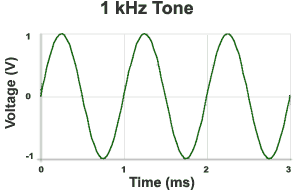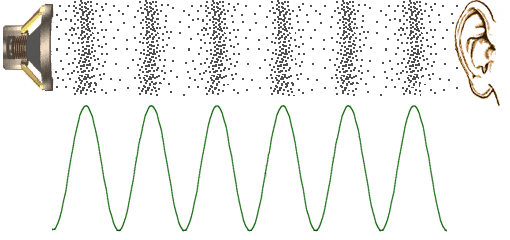How Sound Waves Work
Before you learn how sound equipment works it's very important to understand how sound waves work. This knowledge will form the foundation of everything you do in the field of audio.
Sound waves exist as variations of pressure in a medium such as air. They are created by the vibration of an object, which causes the air surrounding it to vibrate. The vibrating air then causes the human eardrum to vibrate, which the brain interprets as sound.
The illustration on the left shows a speaker creating sound waves (click the button to show animation).
Sound waves travel through air in much the same way as water waves travel through water. In fact, since water waves are easy to see and understand, they are often used as an analogy to illustrate how sound waves behave.

Sound waves can also be shown in a standard x vs y graph, as shown here. This allows us to visualise and work with waves from a mathematical point of view. The resulting curves are known as the "waveform" (i.e. the form of the wave.)
The wave shown here represents a constant tone at a set frequency. You will have heard this noise being used as a test or identification signal. This "test tone" creates a nice smooth wave which is ideal for technical purposes. Other sounds create far more erratic waves.
Click here to listen to this tone (22KB wav file)
Note that a waveform graph is two-dimensional but in the real world sound waves are three-dimensional. The graph indicates a wave traveling along a path from left to right, but real sound waves travel in an expanding sphere from the source. However the 2-dimensional model works fairly well when thinking about how sound travels from one place to another.
The next thing to consider is what the graph represents; that is, what it means when the wave hits a high or low point. The following explanation is a simplified way of looking at how sound waves work and how they are represented as a waveform. Don't take it too literally — treat it as a useful way to visualise what's going on.
In an electronic signal, high values represent high positive voltage. When this signal is converted to a sound wave, you can think of high values as representing areas of increased air pressure. When the waveform hits a high point, this corresponds to molecules of air being packed together densely. When the wave hits a low point the air molecules are spread more thinly.
In the diagram below, the black dots represent air molecules. As the loudspeaker vibrates, it causes the surrounding molecules to vibrate in a particular pattern represented by the waveform. The vibrating air then causes the listener's eardrum to vibrate in the same pattern. Voilà — Sound!

Note that air molecules do not actually travel from the loudspeaker to the ear (that would be wind). Each individual molecule only moves a small distance as it vibrates, but it causes the adjacent molecules to vibrate in a rippling effect all the way to the ear.
Now here's the thing: All audio work is about manipulating sound waves. The end result of your work is this series of high and low pressure zones. That's why it's so important to understand how they work - they are the "material" of your art.
Next Page: Sound Wave Properties